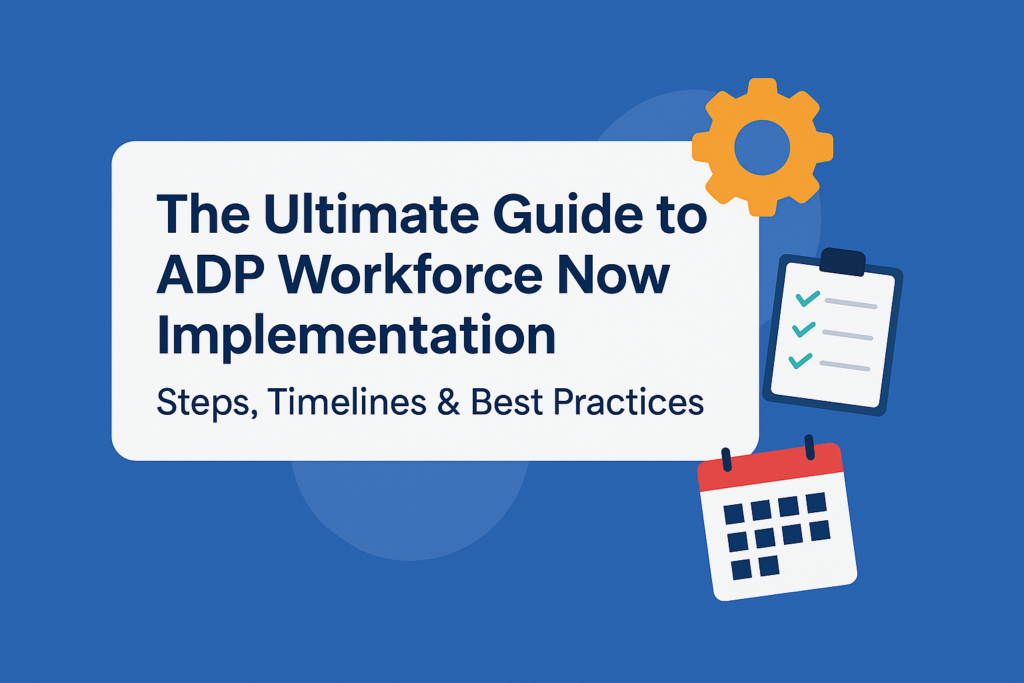Implementing a powerful HR system like ADP can bring tremendous value to your organization—streamlining payroll, improving compliance, and centralizing workforce data. But without careful planning and execution, an ADP implementation project can quickly spiral into delays, budget overruns, and frustrated teams.
At ADP Experts, we’ve seen firsthand how seemingly small oversights during implementation can snowball into major setbacks. In this guide, we’ll walk you through the 7 most common mistakes organizations make during ADP implementations—and how to avoid them.
1. Lack of Clear Goals and Requirements
Too often, companies dive into an ADP rollout without a clearly defined scope. They underestimate the strategic planning required and treat the project like a simple software installation. This leads to misaligned expectations, feature mismatches, and wasted time.
How to Avoid It:
- Start with a discovery workshop involving all stakeholders.
- Define your goals—such as reducing payroll errors or centralizing employee data.
- Create a detailed requirements document aligned with business outcomes.
2. Insufficient Stakeholder Involvement
One of the most critical mistakes is excluding key stakeholders from the implementation process. HR, payroll, finance, compliance, and IT all need to contribute early and often. Without their input, critical functionality can be missed or misconfigured.
How to Avoid It:
- Identify and include all department leads from the beginning.
- Hold regular cross-functional meetings during planning and testing phases.
- Establish an internal project sponsor to align all teams.
3. Underestimating Data Migration Complexity
Data migration is one of the most complex and sensitive parts of any ADP implementation. Inaccurate, incomplete, or outdated data can lead to compliance issues, payroll errors, and poor user adoption.
How to Avoid It:
- Conduct a data audit to clean and validate legacy data before migration.
- Use mapping templates to ensure fields align correctly with ADP’s schema.
- Test data migration multiple times before go-live using sandbox environments.
4. Relying Solely on Internal Resources
ADP is a robust system, and while internal IT and HR teams may be capable, they often lack the platform-specific expertise needed for a successful implementation. Trying to do it all in-house usually leads to missteps and delays.
How to Avoid It:
- Engage certified ADP consultants with proven experience in similar implementations.
- Leverage external experts for complex tasks like integrations, custom workflows, and compliance configuration.
- Train internal teams alongside implementation to build long-term ownership.
5. Neglecting Change Management
Even the best ADP implementation will fail if your employees aren’t prepared to use the new system. Change resistance is natural, especially when new processes disrupt established routines.
How to Avoid It:
- Develop a change management strategy that includes communication, training, and feedback loops.
- Appoint internal champions to promote adoption and answer questions.
- Offer hands-on training tailored to different user roles.
6. Poor Testing and QA Processes
Rushing into go-live without rigorous testing is asking for trouble. Many issues don’t surface until real data and real users hit the system. Payroll errors, benefit miscalculations, and access issues can damage trust fast.
How to Avoid It:
- Develop a comprehensive testing plan including unit, system, and user acceptance testing (UAT).
- Test with a wide range of scenarios—new hires, terminations, bonuses, leaves of absence, etc.
- Allow sufficient buffer time between UAT and go-live for adjustments.
7. Skipping Post-Go-Live Support and Optimization
Implementation doesn’t end at go-live. Organizations that neglect post-launch optimization miss the opportunity to fine-tune processes, improve user adoption, and leverage advanced ADP features over time.
How to Avoid It:
- Plan for 30–90 days of post-go-live hypercare support.
- Review reports and usage data to identify pain points.
- Schedule periodic system optimization reviews with your ADP consultant.
Conclusion: Don’t Let These Mistakes Derail Your ADP Project
ADP implementation is a high-stakes initiative that touches every part of your organization. The most successful projects are led by a clear vision, involve all stakeholders, and are backed by expert guidance from start to finish.
If you’re planning an ADP rollout—or if you’re already mid-way and feeling overwhelmed—ADP Experts can help. Our team of certified consultants has helped organizations across the globe implement, optimize, and support ADP platforms with confidence.
Book a free consultation today and let’s ensure your ADP implementation is a success, not a setback.





